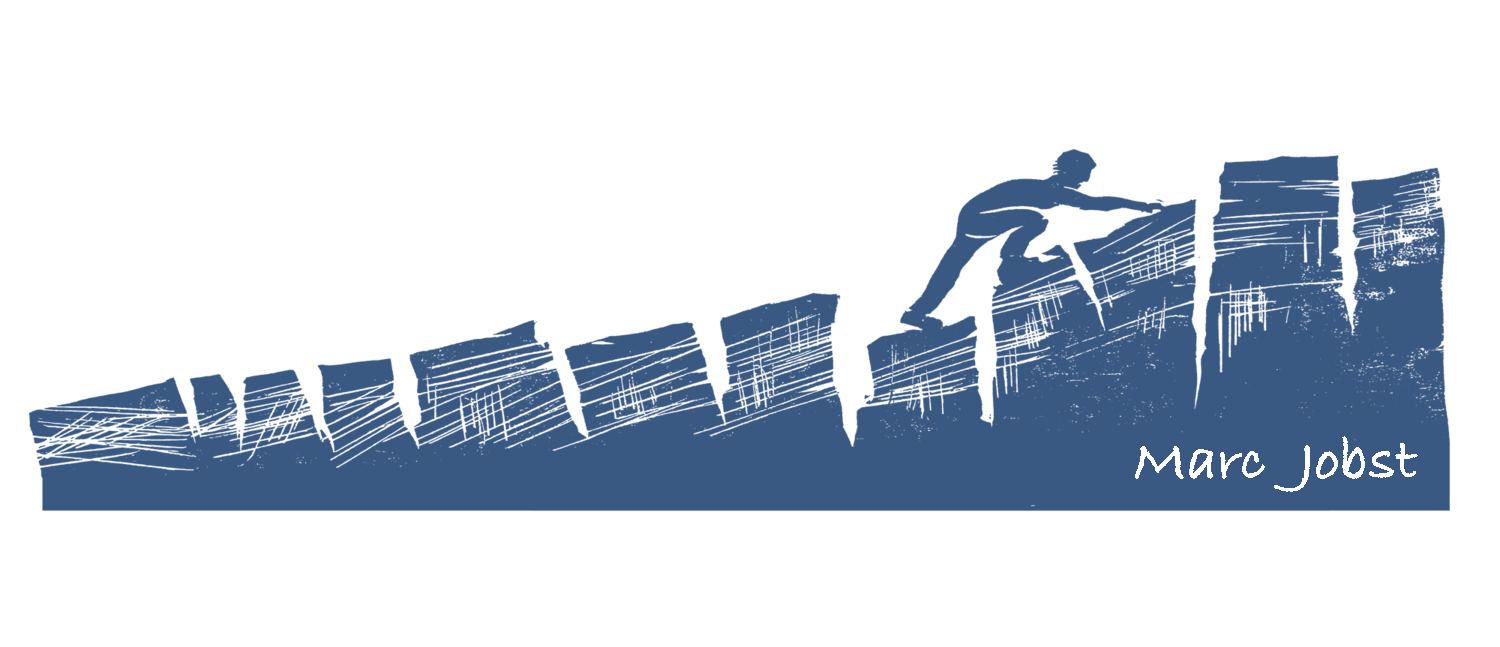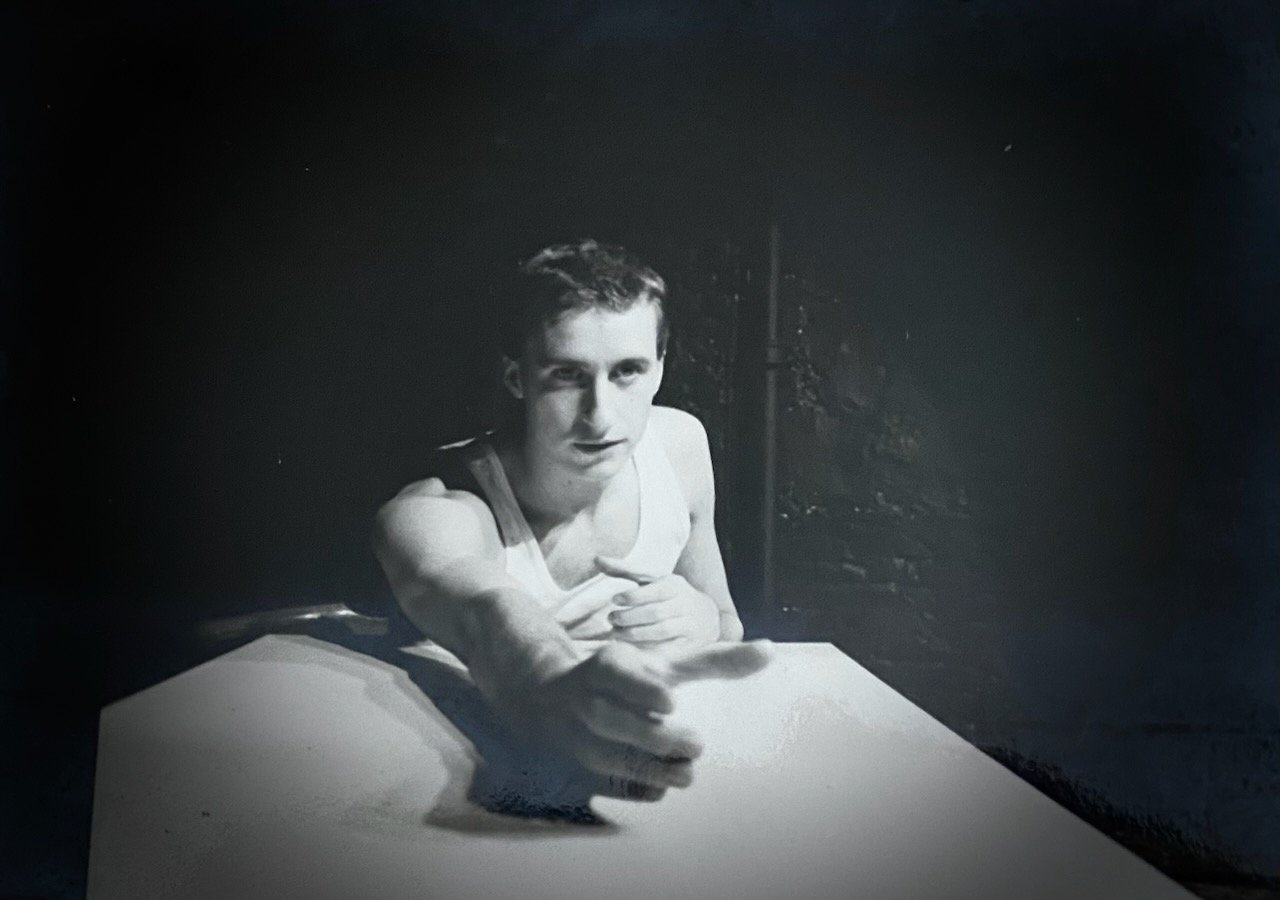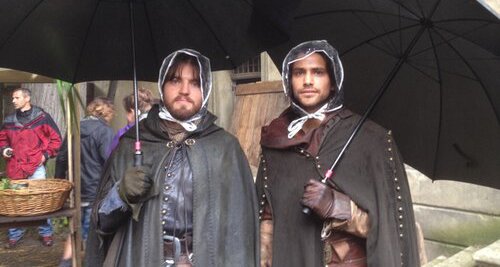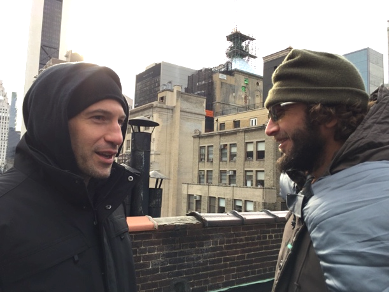Biography
Early Days
The light, the smell, the big skies of Africa run through my veins. They were my very first sounds and senses to our beautiful world. I was born in Zimbabwe. Dad was a cattle rancher, Mum a painter.
We moved to London when I was very young. As a teenager my father taught me to wrangle cattle and I earned pocket money breaking in bulls so they could be led in the auction rooms. Every weekend we went to a centre for craft outside Windsor and I’d learn carpentry, pottery, bookbinding and blacksmithing.
Dad loved cows. I loved stories. Hmmm. I decided to study agriculture at Newcastle upon Tyne University because I knew the Royal Shakespeare Company toured there for 3-months of the year. The plan was to come away with a degree and a training from the RSC!
I loved the focus of rehearsals and improvisations; I also loved the physicality of farming - lambing in the spring, in the Northumberland hills, on a sunny day; cattle ranching in the vast Rocky Mountains of Colorado or in the dry veldt of the Zimbabwe bush.
And stories?
I was fortunate to be in a year of fantastically talented theatre students. We began our independent adult life during the miners strike of Margaret Thatcher’s Britain, in a coal mining city. Being in the heart of the north east, at a time when working families put themselves and their livelihoods on the line, formed me. The city, the theatre, the friendships we forged, the intensity of digesting a fractured world and serving it back as story, shaped my love of storytelling and the role it can play in our lives.
Theatre
I and my friend Tom Richardson, a hugely talented director and later production manager at the National Theatre, set up Three Monkeys Theatre Company. Seven of us formed the core team. We bought an old ambulance from a car auction, ripped out the insides and adapted it to carry our costumes, musical instruments and sets.
We toured the country, living out of each other’s pockets, sleeping in the back of the ambulance, prevailing upon the kindness of friends and family for rooms around the country. We made shows that were intentionally physical, that used music, colour and acrobatics, and that played in schools, theatres and places for people with learning difficulties.
A few years later, I performed a one-man version of Alan Sillitoe’s The Loneliness of the Long-Distance Runner directed by the brilliant John Yorke (https://www.johnyorkestory.com/), also part of The Three Monkeys.
We updated the story to the 1980s, angry at the government’s “short sharp shock” policy for young offenders. Home Secretary, Michael Howard, believed instigating a brutal three months penal regime for young detainees would shock them from offending again. There was no evidence for this, and, worse, no interest to discover why young people are led to offend in the first place.
Three Monkeys first show an adaptation of Thomas Hardy’s short story The Withered Arm that used drama, movement and five part harmony songs.
One-man version of Alan Sillitoe’s The Loneliness of the Long-Distance Runner directed by the brilliant John Yorke.
The show opened at the Edinburgh festival, received good reviews and was picked up by a London impresario. We transferred to a theatre in Chelsea and initially played to 2, 3 sometimes 4 people in the first few nights. One night Time Out, London’s pre-eminent listings magazine, came to the show. They made it Critic’s Choice. The next day we sold out. We toured the country and returned to London for a long, exhausting, successful closing season.
But I was broke and needed to earn money.
Contemporary adaptation of The Loneliness of the Long Distance Runner performed as a one man show.
Radio & Documentaries
Occasionally someone holds out a hand at the right moment and gives you the lift you need. Charlie Bowden was that hand. He ran a highly regarded farming programme for Tyne Tees TV in Newcastle, Farming Outlook, and took me on as a researcher. Back to my roots. I had a car, some expenses and a brief to find interesting stories that would make great films for the weekly broadcast. My patch was the whole of the north of England and Scotland: sea, moorland, deep dale and mountain high - some of the country’s most stunning landscapes. What a brief!
From Tyne Tees TV I joined the BBC to help set up its new farming and environmental programme, Country File. A joyous year spent researching and making short films for the new magazine programme. I also directed my first full documentary – the story of Ed Harper, a blind goat farmer on the remote Cape Clear Island off the south coast of Ireland.
To bring my theatre and musical training to my love of story, I left network television to work for BBC Radio 4 where I could express the full range of my passions. BBC Radio 4 is one of the most unique and treasured stations in the world – a mixture of documentary, drama, comedy, features, and magazine programmes. I worked in them all as producer/writer/director. Using sound only to tell a story is a formidable challenge. It teaches you so much about structure. Narrative construction – how and when you hide, reveal, elucidate – leads an audience through a story. If your structure is wrong you lose the audience in an instance, because there are no pictures, landscapes, or people to distract.
It also teaches you how to stimulate the imagination of the audience to conjure mood, atmosphere, and tone, just with sound. It is one of the reasons why sound and music are so important to me in film making - critical tools in a storyteller’s toolbox.
RADIO
Out of the Fire was a multiple award-winning documentary series I made with BBC Foreign Affairs Editor John Simpson. We told the stories of how ordinary people survived extraordinary world events – Chechnya, Cambodia, Albania, Rwanda, South Africa, Russia, Iran, amongst others. Stories of unbelievable fortitude and courage.
Booked! was a peak time, literary panel game with the brilliant Barnsley poet, Ian McMillan as host (@IMcmillan). One evening, whilst on the road, he told me he was writing poetry with underage prostitutes for an organisation called Street Reach in Doncaster. Radio is quite a solitary process, and I felt the need to collaborate with other artists. With a commission from the BBC, and permission from all the young people and organisaiton, we made a film together - to the rhythm of the tango - called SUMMAT ELSE – a line from one of their poems.
Receiving the Amnesty International Award for “Chocolate Soldier from the USA”.
From Radio to Documentaries
I spent months getting to know the young women, finding out about their circumstances and their lives - incredible stories of difficult childhoods, neglect, and survival – and gaining their trust. When the cameras rolled, they clammed up and told me the bare minimum. It was of course deeply frustrating but totally understandable. As a documentary maker you absolutely must be true to the material you gather, especially having gained their trust. Clearly the film became limited by what they were willing to tell me on camera. I came away wondering whether I could tell a truer picture of their lives if I wrote it. By fictionalising the characters, I could actually tell a more truthful picture in drama.
I was being brought back to my theatre roots.
Television & Film
From Documentaries to Drama
In 1999 I left the BBC to make my first live action film, a short: CALLING THE WILD. It was commissioned by ITV’s “new writer/director” scheme. It wasn’t about the women of Street Reach, but about the growing domination to our lives of the mobile phone.
The film won a couple of awards and I managed to hustle my first directing jobs – including the BBC’s flagship continuing dramas Eastenders and Casualty. Eastenders is shot on 3 cameras and cut live as you shoot, so every shot must be planned in advance to give to the vision mixer to work from. Casualty is a hospital drama – the British ER - and involves studio and location work, action, intense human drama, and some big set pieces. Everything I learned on those fast pace shows develops discipline as a director that I use in my work to this day.
THE WOLVES OF GYSINGE: The BBC Natural History Unit in Bristol asked if I’d be interested to write and direct a series of films for them using drama, to tell the natural history of the rare humankind-killing animals across the world. There was the story of a lion in Africa, a leopard in India and a wild wolf in Sweden. I chose the wolf story, Manhunter: The Wolves of Gysinge. We shot it in the Carpathian Mountains of Poland in -26C temperatures. It was an innovative and exciting proposal, and a totally new way of working for one of the most esteemed documentary film making departments in the world.
Since becoming freelance as a writer and director in 1999, I use my grounding in theatre every day. It has given me the skills and confidence to work with actors in intense, character-led dramas. And the physicality and emphasis on story theatre teaches is the backbone to how I approach some of television’s biggest character-driven action shows.
Every drama I did I learned more about my craft: working with writers, producers, actors, trying things out, discovering what the camera can do, learning how to use film, colour, sound, framing, lenses, to express the meaning and intent behind a scene.
These Include:
Hannibal NBC
Tin Star Sky/Amazon/HBO
The Witcher Netflix
Sleep With Me ITV Studios
Criminal Justice BBC
Daredevil, Luke Cage, The Punisher Marvel Studios/Netflix
Berlin Station Epix/Paramount
Black Sails Starz
The Musketeers BBC
The Paradise BBC
Jupiter’s Legacy Netflix
One Piece Netflix
Behind the Scene thoughts on Directing
SLEEP WITH ME I HANNIBAL I DAREDEVIL I BERLIN STATION I TIN STAR I THE WITCHER
For those interested, I’ve delved into a few of the shows to reveal a little more of my thinking and approach.
SLEEP WITH ME
Amongst many great producers I forged a particularly strong working relationship with the prodigiously talented Steve Lightfoot. We made several films together, including the feature length adaptation of Joanna Briscoe’s erotic thriller Sleep With Me, described as “the next Single White Female”. Acclaimed screenwriter Andrew Davies (Bridget Jones’ Dairy, Pride and Prejudice, House of Cards) wrote the adaptation from a best-selling novel by Joanna Briscoe. It’s the story of a couple on the brink of serious commitment as they conceive a baby, whose lives become disrupted by the arrival of a demure and seductive French woman. Sylvie insinuates her way into their lives and begins an affair with each of them driving a wedge between the couple.
I pitched a vision that brough a classic European sensibility to the adaptation, in the vein of Breathless or The Piano Teacher. It chimed with Steve and the studio head, Murray Ferguson, and we found a fantastic cast.
Together with the talented cinematographer, Florian Hoffmeister (http://florianhoffmeister.de/), we studied the paintings of Wilhelm Hammershoi to bring an airless, claustrophobic stillness to the flashbacks, helped by the sensuality of shooting on 35mm film.
Florian’s team which included some of the world’s top ACs and dolly grips in the business. For the first time I witnessed the breath-taking skill of their craft. Hairs literally stood up on the back of my neck.
Click Here: Joanna Briscoe: How my novel was brought to life
In 2014, whilst in Prague shooting the BBC’s lavish production of The Musketeers, I was called by agents in the US, offering to represent me.
The Musketeers: Tom Burke (Athos) and Luke Pasqualino (D’Artagnan) waiting for the rain to pass…or for the opportunity to play Mary Poppins.
HANNIBAL
As I drove to Heathrow to fly to LA to meet them, Steve Lightfoot called to ask if I’d be interested to shoot an episode of Bryan Fuller’s cult hit, HANNIBAL for NBC on which he was joint show runner. I landed in LA, met with my new agents, and jumped straight back on a plane to Toronto to start production.
This was, unquestionably for me, a baptism by fire into high-end drama, into Bryan Fuller’s unique, operatic vision for the show, and into working with legendary actors Mads Mikkelson, Laurence Fishburne, Hugh Dancy and Gillian Anderson. Our DoP, James Hawkinson, lit the actors and sets with such dark precision that I needed a torch to see the scripts we were shooting!
DAREDEVIL
A stint on Eli Roth’s show Hemlock Grove brought me to Netflix and Marvel Studio’s attention, and I was offered a key episode in Daredevil series 2 to direct. In “New York’s Finest”, The Punisher (Jon Bernthal), captures Daredevil (Charlie Cox) and ties him to a chimney on the rooftops of Manhattan. The two fiercely debate their different positions: Revenge vs Forgiveness. There was some concern that the episode would be too like a stage play, but it was brilliantly written by Mark Verheiden, and Jon and Charlie committed so completely that the film lifted off the page in a mesmerizingly played two-hander.
Charlie Cox & Jon Benthal, Daredevil & The Punisher
Jon Benthal, The Punisher
With two-hander, dialogue heavy scenes I would expect to shoot between 6-8 pages in a day. It can be hard to break up big scenes that follow an argument over longer than 8 pages, and then pick up where you left off with the same intensity the next day. So, in the heat of the New York summer, shooting from 5pm to 5am every night, on the rooftops of Manhattan, Charlie and Jon asked to take a run at completing whole scenes rather than breaking them up. Being true professionals they’d learned the dialogue, and we all agreed to give it a go. It paid off. Not only were we able to shoot a 14 page day, but most importantly, we kept the intensity fully for each scene, and they delivered riveting, electric, dangerous performances that brought these two formidable characters into conflict
Charlie Cox, Daredevil
Single-shot action sequence. This episode also had the much-talked about “single-shot” fight sequence down the stairwell. This was not about just doing a cool shot. Nor was it about creating a series two “oner” in the same tradition of the brilliant corridor sequence Phil Abrahamson shot in series 1. Instead, I chose to shoot it that way for strong story reasons. If we break a fight into lots of cuts, we can lose touch with the bigger story – the purpose of the fight – and the sequence can just become about who hits hardest and who wins. In this case, Daredevil needed to race to the bottom of the stairs, to prevent The Punisher escaping from the elevator.
Fortunately, Phil Silvera, the stunt coordinator, embraced the idea – and I managed to persuade Marvel and Netflix to let us go ahead.
On the first day of shooting this sequence on location, we ran into an unexpected structural problem. For 6 hours we tried to solve it but failed. By now Marvel in LA was waking and seeing the daily log, which showed nothing had been shot! They were very twitchy. I was under pressure to break the fight into traditional shots and cuts. My first assistant director, Jason Ivey, held them off for me, and with the help of the immense Charlie Cox (who is always willing to embrace a challenge, support a vision, find solutions), we found a solution. Together with Charlie’s phenomenal stunt double, Chris Brewster, we shot this ambitious sequence in 3 very intense days and in the fierce heat of a New York summer.
Over the years, and many more shows, I built a strong, trusting relationship with Netflix and Marvel Studios. I shot the opening episode of Daredevil series 3, two episodes of Luke Cage, The Punisher and The Runaways.
Mike Colter, Ron Cephas Jones, Rosario Dawson, Luke Cage
Mustafa Shakir
DoP Manuel Billeter and tiny clapper board
Jon Benthal and Ebon Ross-Bachrach, The Punisher
Daniel Webber
Daredevil: Rain bars, cameras and lights. Shooting Manhattan for the opening episode of Series 3.
Video village, The Punisher
Mahershala Ali and Theo Rossi, Luke Cage
BERLIN STATION
Jason Horwitch, one of the writers on Luke Cage, became showrunner of Epix/Paramount’s high-octane spy thriller, Berlin Station. He invited me to direct the final two episodes of the series. With the outstanding cast of Richard Jenkins, James Cromwell, Ashley Judd, Rhys Ifans and Leland Orser, we shot in Budapest, Berlin, and Vienna. One of the greatest privileges of being a director is to watch two actors like Richard Jenkins and James Cromwell deliver a masterclass in acting - listening to each other, responding to each nuance and rhythm change, and reminding us all of the magic of what we do
James Cromwell
Richard Jenkins
Leland Orser – unfailingly cool
With Ismael Cruz Cordoba discussing final fight sequence
With Hagen Bogdanski (DP), Rhys Ifans, Nikolai Kinski
Lining up a shot of Nikolai Kinski on the monitor
TIN STAR
Alan Clarke’s Scum in 1982, and Tim Roth’s explosive performance as Trevor in Made in Britain, blew apart everything I knew about story telling. It tore away the artifice of pre-packaged perfection, ripped into our comfortable worlds and gave us unforgettable, raw characters. When I was invited to direct Tim in Sky Atlantic and Amazon Prime’s Tin Star for Kudos, I jumped at it. The series had a contemporary, western feel to it with Tim as the small-town Sheriff with a (very) dodgy past, and Christina Hendricks as the evil face of business. We shot in the mountains of Alberta. Watching Tim’s ability to convey complex story and emotion so much with his face and body, without the need for pages of dialogue, was a revelation. It is a uniquely cinematic form of acting.
Stephen Walters
Tim Roth
Oliver Coopersmith
Christina Hendricks
THE WITCHER
The Witcher was shot in Hungary, the Canary Islands and Poland. A high stakes commission by Netflix, with a massive, ardent fanbase, and a big vision from showrunner Lauren Schmidt.
I was brought in to help reshoot the action and Blaviken storylines in the pilot, as well as direct the finale of the series.
Henry Cavill is an exceptional swordsman and athlete. We wanted to use. all his physical skills to reveal Geralt’s danger, in the very first episode. At his suggestion we brought in the fight team Henry and Tom Cruise had worked with on Mission Impossible.
The sword fight in the pilot episode fell into two separate sections: the first was an out and out fight between a bunch of thugs; the second, an emotionally confusing fight with the woman he’d just shared the night with, Renfri.
Shooting the Marvel shows for Netflix I learned that when an action sequence relies too heavily on quick cuts to sell the hits, the audience can tire and get bored. It was very important to me to work with the stunt team to design a sequence that kept the audience engaged with Geralt’s story, so when he met Renfri, they really cared what would happen. If the audience had just been through an extensive fight, with lots of cuts and expositional action, and then had to go through another one with Renfri, there was real danger they wouldn’t have the appetite to fully engage. I wanted the audience to scream at Renfri not to take Geralt on because they’d just seen how dangerous he can be. I also wanted their fight to carry sexual charge from the night before: a sense of “will they fight, or fuck”.
But how?
I decided to shoot the first section of the fight with the thugs, in a single shot. That served two purposes:
Firstly, it would show how dangerous Geralt is – important for the pilot episode, and for setting up the Renfri fight,
Secondly, because there’d be no cuts, I could then control the pacing, intimacy and shape of the fight with Renfri using cuts, to fully land the emotion behind the fight.
Laying the carnage for the pilot sword fight
Packy Lee preparing to have his head chopped off
On shoot day, the heavens opened. It rained torrentially, throughout. It was impossible to shoot such a complex and dangerous sequence: the swords were heavy (not sharp), and Henry and the stunt team were not holding back in the ferocity of their movement. To complete a sequence safely and successfully, the actors and stuntpeople needed to be 100% confident of their grip underfoot. We had to reschedule. The forecast for the coming days remained stormy and wet and by now we were at the very end of the entire Witcher shooting schedule. The only way we could go ahead was to dig up the entire playing area, lay gravel underneath to soak away the water, fill in with sand to drain the rain away, and finish with a layer of soil on top to blend with the location.
We hired a camera operator, Stefan Stankowski, to work exclusively with the fight designers, to learn the dance of choreography so the camera could always get to where it needed to be, to land the hits without having to sell it through cuts. The whole sequence took several weeks to design and to rehearse, with Henry joining whenever he wasn’t needed on set (rare!). The sequence would not have been possible without the stunning work of Wolfgang Stegemann (stunt coordinator, https://www.wolfgang-stegemann.com/), the fancy footwork of Stefan, Henry’s skills as a swordsman and the impeccable stunt work of Renfri double Lucy Cork.
The Witcher Stunt Rehearsal Monitor 1
The Witcher Stunt Rehearsal Monitor 2
Storyboards/finished frames
After the final shot for Series One
Sean Guest (1st AD), Ildiko Kemeny (co-prod), Lauren Schmidt (Showrunner), myself, Tera Vale Ragan (Lauren PA), Marcell Belso (my PA)
Beyond Work
I live in England, in the country, with my wife, three children and a dog. I play classical guitar, watch movies, theatre and go to concerts, and when the brain needs a break, I run, play tennis, cook, try to surf, sit at the wheel and throw pots. One of my greatest pleasures is to sit around a fire outside with friends and family, cooking on the flames, maybe fashioning a spoon out of wood, and chatting!






















































































